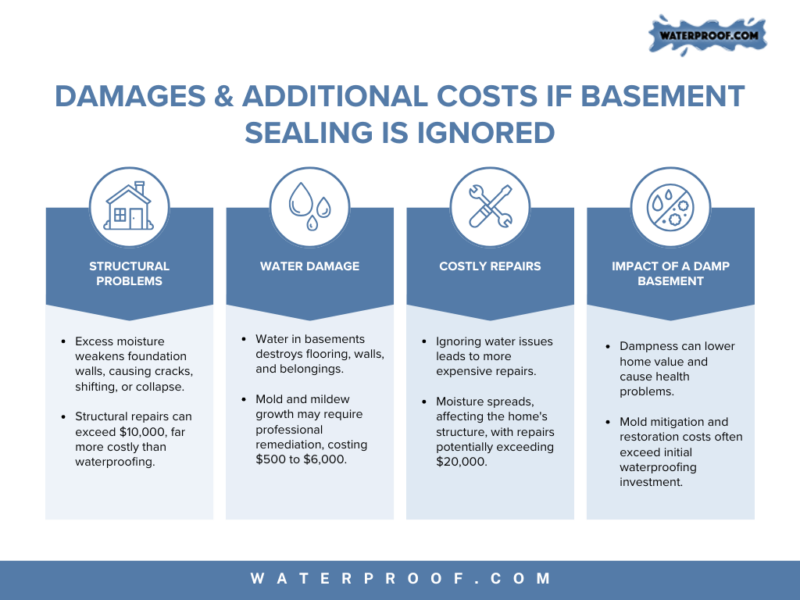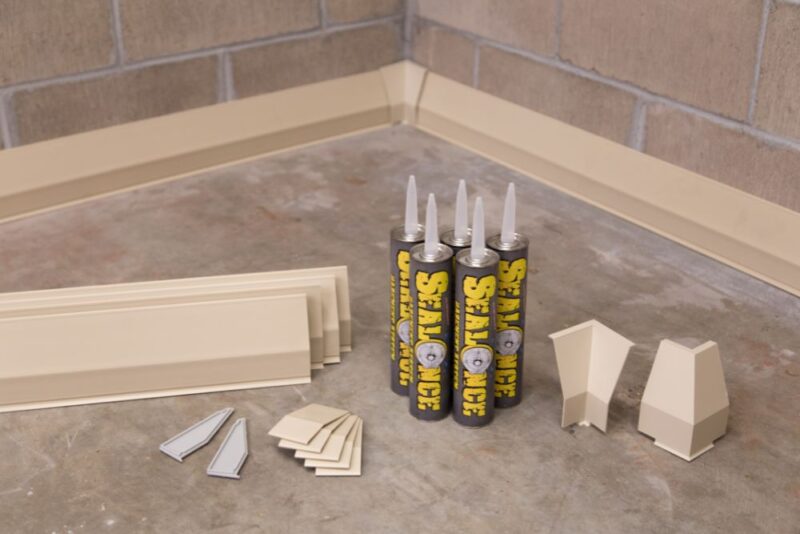The cost of basement waterproofing can vary widely depending on the method you choose and the severity of the problem. The average cost to waterproof a basement can range anywhere from $2,000 to $15,000 or more. Simpler solutions, like applying waterproof paint or installing a sump pump, may cost a few hundred dollars, while more extensive projects, such as installing an exterior drainage system, can reach the higher end of the spectrum.
Factors Affecting the Cost of Waterproofing a Basement
Several factors influence the cost of waterproofing a basement, from the type of water intrusion to the size of the space. Here’s a breakdown of key considerations:
1. Source of Water
The origin of the water problem—whether it’s condensation, wall cracks, seepage, or hydrostatic pressure —affects both the method and the cost of waterproofing. Simple fixes, like a dehumidifier for condensation, are less expensive than foundation repairs.
2. Basement Size and Layout
Larger basements or those with complex layouts will be more expensive to waterproof due to the increased material and labor needs. Costs typically scale with square footage.
3. Soil and Moisture Conditions
Soil moisture levels and type around your home can increase costs, especially in flood-prone areas where more extensive waterproofing methods could be needed.
4. Foundation and Wall Condition
Cracked or damaged foundation walls require repairs, which can add to your overall cost. A solid, intact foundation allows for less expensive solutions.
5. Geographic Location
Waterproofing costs vary based on local labor rates and the flood risk of your area. Homes in high-risk areas may need more robust and costly waterproofing systems.
6. Preventative Measures
Simple actions like adjusting downspouts and filling low spots can reduce water intrusion, helping to lower the overall cost of basement waterproofing.
Basement Waterproofing Costs and Methods
The cost of waterproofing a basement depends on the method used. Here’s a breakdown of the most common interior and exterior waterproofing solutions and their associated costs.
CONDENSATION
Condensation is when water droplets in humid air comes in contact with cold surfaces turning the vapor into water. Condensation often collects on concrete walls and floors. A low cost remedy to this type of basement condition is simply add a box fan to your basement to help circulate the air, which prevents the vapor from condensing and turning into liquid. You could also want to add a dehumidifier to the basement to collect the moisture from the air. For most basements you want to keep the humidity level at or below 50% relative humidity. When you go above 80% humidity your chances of mildew mold growth greatly increase.
Total Cost: $264
$29 for a box fan + $235 for a dehumidifer
LEAKY WALL CRACK
Leaky wall cracks are most commonly found in poured wall foundations. Vertical wall cracks can be fixed by applying a sealant to the crack, like our CRACK Foundation Repair. This will seal off the crack preventing water from entering through the wall crack. It’s important also take preventative measures to keep water from entering your basement and for that you need to take a look outside your home to address key areas that drive water into your basement every time it rains or snow thaws (read the preventative tips above for more info).
Total Cost: $45 to $205
$30 for CRACK Foundation Repair + $15 for simple tools like a putty knife, wire brush & caulking gun. You might also want to add downspout extension around your home to divert the water, which will help prevent pooling water around the foundation. We calculate about $40 per downspout to install an UnderGround Downspout and PVC pipe.
WATER SEEPAGE WHERE FLOOR & WALLS MEET
The joint where the floor and walls meet is commonly called the “cold” or “cove” joint. This is the most common source of a wet basement, affecting nearly 90% of all wet basements. As hydrostatic pressure around your home’s foundation builds up it forces exterior water into the basement through the open cold joint.
Many do-it-yourself homeowners initial idea is to find a way to push back or stop the seepage with waterproofing paints or hydraulic cement. These methods are cheap, “quick fixes” to a leaky basement, but won’t last longterm and often create a bigger problem as water will build up higher in the walls and can find new ways into the basement. Waterproofing paints typically cost around $50 a gallon and require a great deal of prep work labor to apply. Hydraulic cements cost around $10 for a 10 lb. pail, which can be very appealing to a homeowner looking for a cheap fix, but they often regret their choice when water begins to build up in their walls and popping and cracking the hydraulic cement. These bandaid quick fixes should be avoid because they will not solve the problem.
The most expensive basement waterproofing cost and option is exterior waterproofing. This requires a great deal of labor and stress on your home and it has several drawbacks when adding to an existing home. Exterior waterproofing relies on a waterproof membrane sprayed or brushed onto the exterior face of a home’s foundation walls to create a water barrier. The best time to apply an exterior waterproofing membrane is during construction of the home. This can act as a preventative measure to help keep moisture out of the basement.
Exterior waterproofing isn’t an ideal remedy for an existing home, as you would need to excavate around your home to exposed the foundation walls. The biggest drawback to this option for an existing home is the high expense and possible damage and disruption it can cause to your home. Exterior waterproofing membranes and drain tiles are limited in their effectiveness. Most exterior drain tile systems clog overtime with silt, which leaves them useless and inaccessible.
Total Cost: $15,000 to $35,000
Exterior waterproofing is the most expensive and has limited effectiveness on existing homes.
Interior basement waterproofing systems are the best approach to waterproofing an existing home. There are 3 main interior waterproofing options:
1. Above floor baseboard channels are the best do-it-yourself waterproofing option for homeowners because they tap into hydrostatic pressure versus common do-it-yourself methods that try to hold back or plug a wet basement. An above floor baseboard channel doesn’t require busting up your basement floor, which makes a do-it-yourself system friendly. Many contractors install these system in monolithic basements, which means the basement walls and footing are one. You do not want to bust up a monolithic basement floor. Above floor baseboard channels, like the SealOnce™ Basement System, is very effective option (and affordable) and will dry up a basement who’s water source is through the cold joint.
Total Cost: $6 per ft (DIY Installation) to $30 per ft (Contractor Installation)
SealOnce™ Basement System is a permanent do-it-yourself fix to a wet basement. You will save yourself thousands of dollars installing the system yourself, but many contractors offer these non-invasive channels.
2. Footer drainage systems are a favorite among contractors because it requires less labor then old-fashioned pipe and gravel and is extremely effective. Footer drainage systems require busting up your basement floor to expose the footing, then a drainage channel is placed on top of the concrete footing around the perimeter of the basement draining into a sump pump system. A benefit to this type of system is it is not sitting in any dirt or soil that could clog the system.
Total Cost: $20 to $35 per ft
Footer drainage systems are a professionally installed basement waterproofing channel that is very effective, but will cost several thousands of dollars.
3. Subfloor drain tile systems are an industry standard in basement waterproofing. These systems vary in sophistication and effectiveness. Old-fashioned pipe and gravel is very cheap in material costs, but expensive in labor costs as you need to bust up and dig very large, deep trench in a basement floor for it to be effective. Old-fashioned pipe and gravel is an effective system, but has it’s drawbacks. These systems frequently get clogged because they are sitting in dirt. They need a good deal of pitch and a lot of water in them to create flow. An old-fashioned drain tile job would likely take 2 to 4 days and would cost several thousand dollars (mostly paying for labor). The basement waterproofing industry has evolved greatly over the past few decades in the development of hybrid basement waterproofing systems that are more effective with water flow then old-fashioned pipe and gravel, and require a lot less labor. Many of these new systems come with inspection ports, giving you access to the system after its been installed to flush the system out if needed.
Total Cost: $25 to $55 per ft
Subfloor drainage systems are a professionally installed basement waterproofing channel that is very effective, but will cost several thousands of dollar.
SEEPAGE THROUGH THE MIDDLE OF FLOOR
Having a leak up through the middle of your basement floor is uncommon. If you have a crack in your basement floor that is leaking you’ll want to figure out if the water is truly coming up through the floor or if the crack is being feed by the wall and cold joint area (this is most often the case). If the water is coming up through the middle of the basement floor a subfloor system is necessary to remedy this problem. A contractor will install a subfloor system around the perimeter of the basement floor and will most likely run a vein out into the middle of the basement to collect the water in the center of the foundation.
Total Cost: $25 to $55 per ft
A subfloor drain tile system is necessary to remedy this type of wet basement.

Damages and Additional Costs if Basement Sealing is Ignored
1. Structural Problems
Excess moisture can weaken your foundation walls, leading to cracks, shifting, and even collapse. Repairing structural damage often costs far more than proactive waterproofing, sometimes exceeding $10,000.
2. Water Damage
Unchecked water can destroy basement floors, walls, and personal belongings. Water damage can also lead to harmful mold and mildew growth, which requires professional remediation and can cost between $500 and $6,000, depending on the extent of the damage.
3. Costly Repairs
The longer water issues are ignored, the more expensive the repairs become. Moisture can spread to other parts of the home, affecting structural integrity and requiring larger-scale repairs that could easily exceed $20,000.
4. Impact of a Damp Basement
A damp, musty basement can reduce the overall value of your home and cause long-term health problems for residents. The cost of mitigating mold and restoring your basement’s usability far outweighs the initial investment in waterproofing.
Addressing waterproofing early prevents these issues, saving you from much larger repair bills down the line.
Preventative Tips to Keep Your Basement Dry
Before diving into extensive waterproofing projects, there are several preventative steps you can take to minimize water issues and maintain a dry basement. These measures are simple and cost-effective, helping reduce the likelihood of needing major waterproofing work later on.
1. Inspect and Maintain Gutters and Downspouts
Ensure your gutters are clear of debris and properly directing water away from the foundation. Downspouts should extend at least 8 feet away from the house to prevent water from pooling near your basement walls.
2. Grade Your Landscape
Check the grading around your home’s foundation. If the ground slopes toward the house, water will naturally flow into the basement. Filling in low spots and creating a slight slope away from the foundation can help keep water at bay.
3. Seal Cracks in Foundation and Walls
Regularly inspect your foundation and basement walls for small cracks. Use hydraulic cement or waterproof coatings to seal these cracks, preventing water from seeping in.
4. Extend Downspouts and Redirect Water
Use downspout extensions to ensure water is directed away from the foundation. Additionally, avoid allowing water to pool around sidewalks or patios near the home, as these can cause water to seep toward your foundation.
5. Maintain Proper Drainage Systems
Make sure that your home’s drainage systems, including sump pumps and French drains, are functioning properly. Periodically test these systems to ensure they can handle heavy rainfall or flooding events.
By implementing these simple tips, you can often avoid the need for costly waterproofing solutions, especially in areas with minor water intrusion.

Why Choose Waterproof for Your Basement Waterproofing Needs
When it comes to basement waterproofing, you want a solution that not only addresses current issues but also protects your home in the long run. With over 50 years of experience, Waterproof is the trusted choice for homeowners and contractors alike. We offer reliable and proven waterproofing systems that fix moisture problems permanently, whether you’re dealing with minor leaks or major flooding.
At the end of the day, hiring a waterproofing contractor brings a heavy price tag. With the cost of labor for these repairs, many homeowners find a better solution in DIY waterproofing products. If you plan to waterproof your basement yourself take a look at our DIY basement waterproofing guide for helpful tips and advice. If you’re looking for a quote for your basement project visit our SealOnce™ Basement System.
At Waterproof, we understand that each basement is unique. That’s why we provide tailored solutions to meet your specific needs.
Don’t wait for your wet basement to become a bigger problem. Let us help you find the right solution to protect your home and provide peace of mind. Contact Waterproof today.

